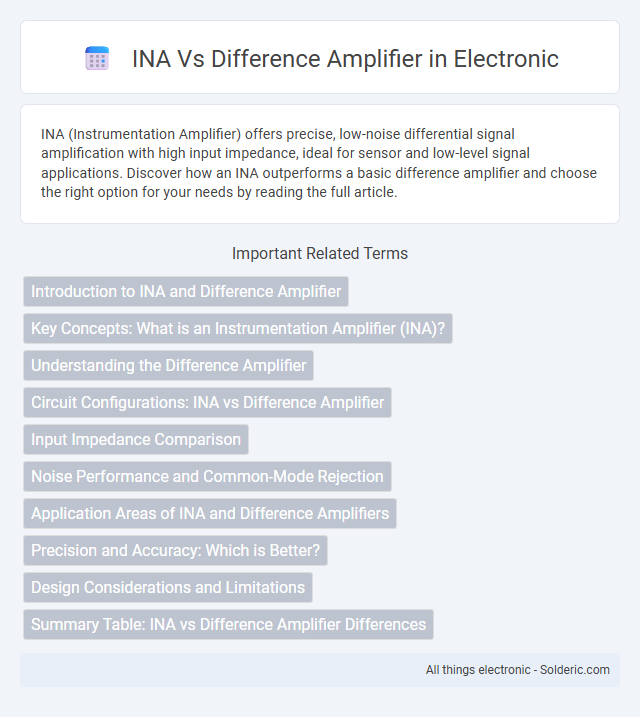INA (Instrumentation Amplifier) offers precise, low-noise differential signal amplification with high input impedance, ideal for sensor and low-level signal applications. Discover how an INA outperforms a basic difference amplifier and choose the right option for your needs by reading the full article.
Comparison Table
| Feature | Instrumentation Amplifier (INA) | Difference Amplifier |
|---|---|---|
| Purpose | Accurately amplify small differential signals in noisy environments | Amplify the voltage difference between two inputs |
| Input Impedance | Very high, minimizing source loading | Moderate, can load source if not buffered |
| Common-Mode Rejection Ratio (CMRR) | High CMRR, typically > 100 dB | Lower CMRR compared to INA |
| Gain Adjustment | Gain set by a single external resistor | Gain set by resistor ratio, more complex tuning |
| Complexity | More complex, typically 3 op-amps internally | Simple, usually a single op-amp circuit |
| Applications | Sensor signal conditioning, biomedical amplifiers, strain gauges | Basic difference amplification, signal subtraction |
| Noise Performance | Low noise, optimized for small signal amplification | Higher noise compared to INA |
Introduction to INA and Difference Amplifier
Instrumentation amplifiers (INAs) feature high input impedance, precise gain control, and excellent common-mode rejection ratio (CMRR), making them ideal for accurate low-level signal measurements in noisy environments. Difference amplifiers provide a simpler design that amplifies the voltage difference between two inputs but typically exhibit lower input impedance and CMRR compared to INAs. Both components are crucial in analog signal processing, with INAs favored for precision applications and difference amplifiers used for general-purpose differential voltage amplification.
Key Concepts: What is an Instrumentation Amplifier (INA)?
An Instrumentation Amplifier (INA) is a precision amplifier designed to amplify low-level differential signals while rejecting common-mode noise, making it ideal for accurate and stable measurements. Unlike a standard difference amplifier, an INA typically consists of multiple operational amplifiers configured to provide high input impedance and adjustable gain with excellent common-mode rejection ratio (CMRR). Your choice of an INA ensures enhanced signal integrity in environments with electrical noise, crucial for sensor signal conditioning and precise data acquisition.
Understanding the Difference Amplifier
A difference amplifier amplifies the voltage difference between two input signals while rejecting any voltage common to both inputs, making it essential for accurate signal measurement in noisy environments. Unlike instrumentation amplifiers (INAs), which offer higher input impedance and better precision through multiple amplification stages, difference amplifiers are simpler and often integrated into INA designs. Understanding the difference amplifier helps you grasp its role in minimizing noise and offset voltages for precise differential signal extraction.
Circuit Configurations: INA vs Difference Amplifier
Instrumentation Amplifiers (INAs) use a three-op-amp configuration that provides high input impedance and excellent common-mode rejection, ideal for precise low-level signal detection. Difference amplifiers typically employ a single op-amp with four resistors, offering a simpler design but lower input impedance and common-mode rejection compared to INAs. Your choice depends on the required accuracy and complexity of the signal amplification in your circuit application.
Input Impedance Comparison
Instrumentation amplifiers (INAs) typically offer significantly higher input impedance, often in the range of megaohms to gigaohms, compared to difference amplifiers, which usually have input impedances in the kiloohm to megaohm range. The high input impedance of INAs is achieved through the use of buffer stages or input amplifier stages that minimize loading effects on the signal source. This characteristic makes INAs especially suitable for measuring signals from high-impedance sensors or sources, whereas difference amplifiers might introduce signal attenuation or distortion due to their lower input impedance.
Noise Performance and Common-Mode Rejection
Instrumentation amplifiers (INAs) exhibit superior noise performance compared to difference amplifiers due to their precision input stage and lower input noise voltage density, making them ideal for low-level signal applications. INAs provide enhanced common-mode rejection ratio (CMRR), often exceeding 100 dB, by utilizing matched input transistors and symmetrical architecture, which significantly reduces interference from common-mode signals. Difference amplifiers generally have lower CMRR and higher noise figures because of their simpler design, limiting their effectiveness in environments with high common-mode noise or weak signal detection requirements.
Application Areas of INA and Difference Amplifiers
Instrumentation amplifiers (INAs) excel in medical devices, precision sensor signal conditioning, and data acquisition systems where high input impedance and accurate differential voltage measurement are critical. Difference amplifiers are commonly used in audio processing, control systems, and low-frequency signal conditioning where simple differential voltage amplification with fewer components is required. Your choice between an INA and a difference amplifier depends on the need for high accuracy, noise rejection, and input impedance in the application.
Precision and Accuracy: Which is Better?
Instrumental Amplifiers (INA) offer superior precision and accuracy compared to difference amplifiers due to their high input impedance, low offset voltage, and excellent common-mode rejection ratio (CMRR). These features reduce measurement errors and improve signal fidelity, especially in low-level signal applications. You benefit from more reliable and consistent readings when using an INA for high-accuracy signal conditioning tasks.
Design Considerations and Limitations
Instrumentation amplifiers (INAs) offer precision and high input impedance making them ideal for low-level signal amplification in noisy environments, while difference amplifiers provide a simpler, cost-effective solution with fewer components. Design considerations for INAs include accurate gain setting, low offset voltage, and high common-mode rejection ratio (CMRR), whereas difference amplifiers require careful resistor matching to maintain signal integrity. Your choice depends on the application's tolerance for noise, gain accuracy, and complexity, with INAs excelling in medical and industrial sensor applications and difference amplifiers suited for less demanding environments.
Summary Table: INA vs Difference Amplifier Differences
INA (Instrumentation Amplifier) provides high input impedance, excellent common-mode rejection ratio (CMRR), and precise gain settings ideal for low-level signal amplification. In contrast, a Difference Amplifier typically has lower input impedance, limited CMRR, and a fixed gain determined by resistor ratios, suitable for simpler differential voltage measurements. Your choice depends on accuracy requirements, input source characteristics, and desired gain flexibility.
INA vs difference amplifier Infographic

 solderic.com
solderic.com